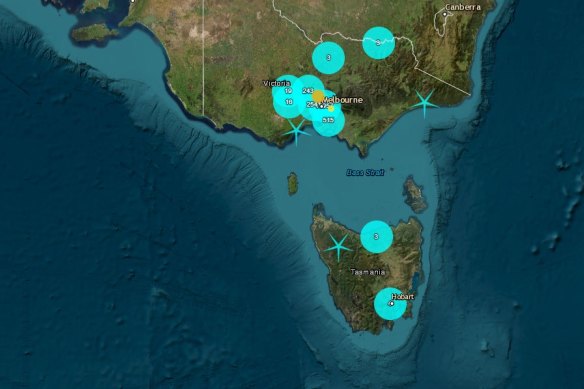What caused last night’s earthquake and is Victoria a hotspot now?

There seem to have been more earthquakes than usual lately. Why?
Save articles for later
Add articles to your saved list and come back to them any time.
At a quarter to midnight, earthquake scientist Adam Pascale sat bolt upright in his bed as the earth shook. Pascale lives in Reservoir, in Melbourne’s northern suburbs, and knew straight away a quake had hit close to home.
The 3.8 magnitude quake happened at 11.41pm, just east of Sunbury, about 33 kilometres from Melbourne’s CBD and 3 kilometres below the Earth’s surface. “That’s why it was felt very widely – the closer to the surface it is, the more you’re going to experience shaking,” says Pascale, chief scientist at the Seismology Research Centre. “And it was in a built-up area.”
The earthquake is the largest in metropolitan Melbourne in 120 years. It was about 100 times less powerful than the Woods Point earthquake in September 2021 that shook Melbourne and caused damage to several properties, but it was much closer to the city, which is why it was so widely felt.
What caused the quake? Is Melbourne becoming an earthquake hotspot? And does this mean there is a big one on the way?
Credit: Design by Cormac Lally, Marija Ercegovac
What caused the quake?
Victoria is being squeezed, quite literally.
Australia is lucky enough to sit at the centre of its own tectonic plate, meaning we have fewer devastating quakes that boundary-straddling New Zealand encounters.
But our plate is under pressure. We are moving north about five or six centimetres a year. “That’s faster than your fingernails grow, so it’s not trivial,” says Mark Quigley, Associate Professor of earthquake science at the University of Melbourne.
As we push north, the sides of our tectonic plate come under enormous pressure. “There are all these car crashes going on around the plate that are transferring stress into the interior,” says Quigley.
Combined with the northern pressure, that places huge stress on the rocks of Australia’s interior. And, every so often, those pressured rocks slip at faults, causing an earthquake.
The Sunbury earthquake likely occurred at a fault about the size of Flemington Racecourse, says Dr Brendan Duffy, technical director at GHD, an engineering service firm that provides earthquake risk assessments.
Most Victorian earthquakes are caused by reverse faults, he said, in which side of a fault slips suddenly relative to the other.
The rocks would have moved about 10 centimetres. That sudden movement released energy in the form of seismic waves, which radiated out and across Victoria.
Melbourne sits on hard, unbroken rock, so these waves can really travel.
Imagine hitting a block of wood with a hammer, says Quigley. If the wood is hard, you can feel the hammer blows at the other end. But if the wood is riddled with cracks, the blows don’t travel as well.
These earthquakes can occur anywhere in Victoria, says Quigley.
And when the fractures reach their stress limits and move suddenly, the entire landscape can be deformed as one side of a fault slides under the other, says Gary Gibson, a seismologist at the University of Melbourne.
The best example in Victoria can be seen on a drive to Bacchus Marsh at the Rowsley Scarp, where flat landscape suddenly gives way to hills, caused by an earthquake in 1978.
More than 20,000 Victorians – and some Tasmanians – submitted a “felt report” to Geoscience Australia after the earthquake on Sunday night.Credit: Geoscience Australia
Is Melbourne a hotspot now?
The quake is the largest to strike within 40 kilometres of Melbourne since 1902, when a 4.5 magnitude quake in Port Phillip Bay shook the city, according to the Seismology Research Centre’s database. The city certainly seems to be having a lot of earthquakes at the moment. Woods Point was in 2021, there was a smaller quake in Melbourne’s east earlier in May, and Frankston was hit in September.
But a list of Victorian earthquakes also makes it clear that most are striking in regional Victoria – not the city itself.
The recent earthquake is part of a normal pattern of seismic activity. “We’d expect to have earthquakes of this size every 50 to 100 years somewhere within the Melbourne metro region. It’s a normal distribution of earthquake activity,” says Pascale.
And this recent quake is not part of a build up to a “big one”, the experts agree. “We’re relatively safe. But we’re going to have these regularly,” says Gary Gibson. “They are perfectly normal, perfectly normal.”
But earthquakes beget earthquakes, as each quake weakens other nearby faultlines. So while we’re not automatically on the path to a big one – it is possible but unlikely – we will get more.
“The more earthquakes you get, the higher the probability is you will get a larger earthquake,” says Quigley.
Fascinating answers to perplexing questions delivered to your inbox every week. Sign up to get our Explainer newsletter here.
If you'd like some expert background on an issue or a news event, drop us a line at [email protected] or [email protected]. Read more explainers here.
Most Viewed in National
Source: Read Full Article

